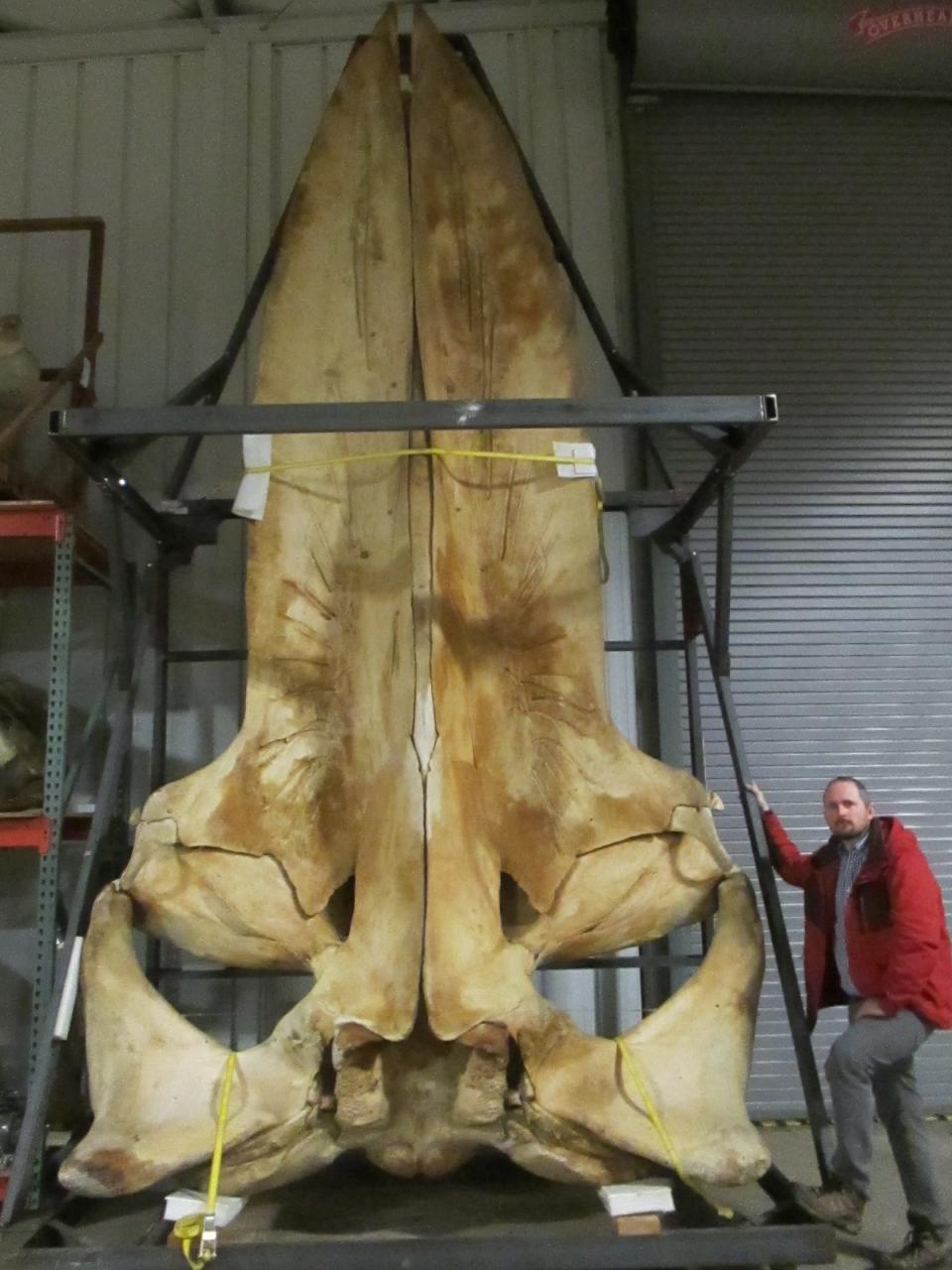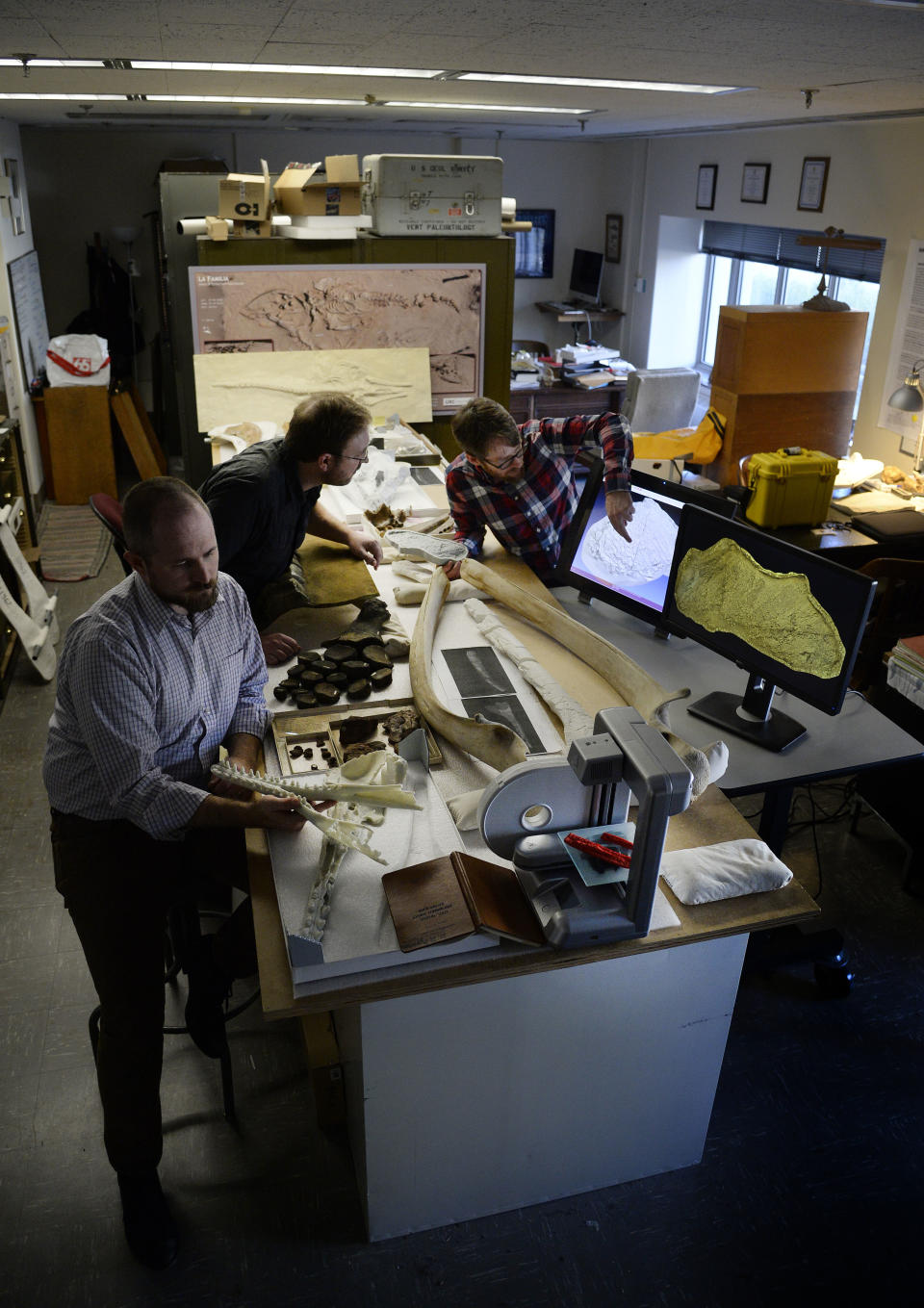How 3D Modeling Is Turning Ancient Whale Bones Into an Ocean of Data

"This is the Raiders of the Lost Ark moment right here."
Nick Pyenson opens a door wide to reveal a vast hangar. It's filled with gigantic whale skulls, extinct dolphin bones, and eight-foot-long narwhal tusks. Dodging shelves of vertebrae, drawers of ancient fossils, and rows of skeletons, Pyenson finally makes it to his work station, tucked away inside a Noah's Ark of long-gone marine mammals specimens.
In January 2016, Popular Mechanics paid a visit to the Smithsonian's Museum Support Center in Suitland, Maryland. It's a facility that the public rarely gets to see, and Pyenson is the keeper of these artifacts. The crowning jewel of the complex is the Marine Mammal Collection, the largest and most comprehensive of its kind in the world. Pyenson, the paleontologist and curator of these fossil marine mammals, keeps track of a hundred million artifacts and specimens saved for future museum exhibits. However, many of them will stay right here, eternally stored in the nation's climate-controlled attic.
Although these creatures departed Earth years ago, their bones are still very much alive, helping to unlock secrets of our oceans' past. "If you want to know how the world might be," Pyenson says, "you need to know how the world was."

A Great Democratizing Force
But to rebuild the past, Pyenson and his team rely on technology of the future-3D modeling and digitization, a technology frequently used in big budget films, video games, and on the faces of American presidents. Pyenson tells Popular Mechanics that this technique is one of the biggest "revolutions" in the natural sciences in this century.
This realization began six years ago in Caldera, Chile, when Pyenson went to work documenting a prehistoric marine animal graveyard uncovered by construction workers widening the northbound lane of the Pan-American Highway. Later, Pyenson and his colleagues discovered that this this surprise paleontological treasure was the densest collection of fossilized marine skeletons in the world.
Because of Chile's federally mandated deadline to finish the highway project, the team had little time and not enough resources to remove the fragile and enormous specimens-some longer than an entire school bus. It was in that moment that Pyenson made a decision that would forever alter the way he would study fossils.

He rounded up the "laser cowboys,"-a group of Smithsonian 3D digitizers who scanned and captured data instead of digging for rock and bone. Using laser scanners and high-resolution cameras, they produced 3D models of half a dozen skeletons uncovered at the sites. Capturing this information helped scientists determine that a harmful algae bloom, which still impacts marine animals today like the Florida manatee, was likely responsible for these mass death events taking place between some 10,000 and 16,000 years ago.
For Pyenson, though, there's something just as important as the scientific conclusions they reached. Specifically, that all of their work-the 3D modeling, photos, research papers, maps, and 360 visualizations-were uploaded online and accessible for all amateur scientists around the world. If you had a 3D printer, you too could print your very own 11-million-year-old whale fossil. "[Our] ability to do this increases the visibility and accessibility of the [work] we do," says Pyenson. "It's a great democratizing force."

Every Good Revolution Needs Its Tools
Five years later, back in his bone-filled lab, Pyenson has become an even bigger believer in the digitization of science. What started as a "technical solution to a scientific problem" has become his modus operandi. Today, every specimen, sample, and piece of data that comes across his desk is digitized in some manner, whether through 3D printing, 2D photographs, or metadata including descriptions of who collected the objects, where they were collected, and any field notes."These objects only have scientific significance when we know that context," says Pyenson. "Objects stripped of context are extremely unhelpful."
Pyenson has long since upgraded from the technologically archaic Canon 5D camera he once use. One of the most important pieces of gear is the Artec Eva scanner (pictured at the top) for capturing and generating 3D models-the very machine used to capture President Obama in 2014. With a white light 3D scanner, the Eva captures three-dimensional geometry by projecting a structured, checkered light grid onto the object and "reading" the grid's resulting deformation with a high-speed camera. How the light distorts is how the shape is determined, producing the equivalent X, Y, Z coordinates in the corresponding software.
The scanner works much like a souped-up Xbox Kinect with better optics and a much higher speed camera. This CCD camera can capture an image nearly instantaneously, in 0.0002 seconds to be exact. That's much faster than a human-much less a fossil that's been dead for thousands of years-could ever move.
Hospital-grade CT scanners, giant humming machine usually used to diagnose brain illness and injury, also peer inside the bones' internal structure. This helps answer questions like how these ancient marine mammals could hear, smell, or see. These scanners sometimes eliminate the laborious and risky process of separating rock from bone. Instead, CT scans penetrate the rock and other materials to capture a 3D image that can then be printed again and again.

However, one of the CT scanners that Pyenson uses isn't quite like the one you'd find at your local medical clinic. He has access to one of the largest micro CT machines on the east coast, provided as in-kind donation of services and scanning time by the military contractor NTS Chesapeake. This large-scale X-ray scanner can fill a 10-foot-by-20-foot room and is incredibly useful when studying ancient blue whale skulls-which, as you'd imagine, are quite large.
But out of all the tech that's used to study Smithsonian's Marine Mammal Collection, the most important modern innovation is the one that 77 percent of Americans have in their pockets. Smartphones have revolutionized how information can be captured-the iPhone 7's 12-megapixel camera nearly matches the top-of-the-line cameras from five years ago-and the ability to share instantaneously.

No Whale Left Behind
Much like his predecessors-researchers like Spencer Fullerton Baird and Dr. Frederick W. True-Pyenson says his main responsibility is being a steward for this collection and ensuring that all the specimens are still here and being used another 150 years. It's the driving reason why he constantly searches for ways to preserve this knowledge and stem the loss of information-"one of the great enemies of museum science," says Pyenson.
With 3D modeling, open-access information, and CT scanning, these tools make sure knowledge is as well-preserved as the fossils themselves. But despite years of work, Pyenson estimates that less than one percent of the collection has been digitized, mostly because of the specimens themselves. Vertebrate fossils come in an extreme variety of sizes that don't neatly match a "one-size-fits-all digitization process." Many objects are so large, around the size of a truck, that the process can become incredibly time-consuming. They just don't have the means to do it all while also doing daily research.
"If you want to know how the world might be, you need to know how the world was."
But Pyenson is in constant communications with other institutions about creating better workflows, processes, tools while other colleagues consider applying for NSF funding.
Once the world's greatest collection of marine mammal bones become more readily available to the public there will be a giant leap forward in scientific discovery, Pyenson says.
[contentlinks align="left" textonly="false" numbered="false" headline="Saddle%20Up,%20Laser%20Cowboy" customtitles="Laser%20Cowboys%20and%20the%20Fossils%20of%20the%20Future" customimages="" content="article.10482"]
Because many oceanic questions still need solving, like why the tusk of the rare and beloved unicorns of the sea always spirals to the left or why whale sharks migrate. It's quite possible that with a 3D scan, a diligent Ph.d. student in California or an amatuer marine biologist in Maldives could help discover those answers with the help of the Smithsonian's Marine Mammal Collection.
"What people may do with the collection could totally be innovative and inspiring," says Pyenson. "There are stories lodged deep in these bones."
You Might Also Like

